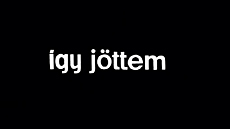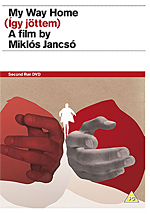 Így jöttem
Így jöttem
Hungary, 1964, black and white, 102 mins
Miklós Jancsó’s third feature My Way Home is a key transitional work in his career. Although still not quite past the embryonic stage, his mature style is now clearly visible, and he’s already managed to ditch the Antonioni influence that cast a long shadow over its predecessor Cantata (Oldás és kötés, 1963). For the first time, we have un film de Miklós Jancsó, owing nothing to and unimaginable in the hands of anybody else.
Indeed, the first ten minutes offers the earliest example of what we now know to be quintessential Jancsó. In 1945, at the end of World War II (an assumption), a motley group of Hungarian partisans (another educated guess) gingerly traverses a rural landscape that grows increasingly treacherous once they lose the cover of the trees. A biplane causes them to scatter, and the seventeen-year-old Jóska is swiftly captured by Hungarian Fascists (presumably). They are captured in turn by mounted Cossacks, who shoot everyone but Jóska. For the first time, we are confronted with what would become one of the key themes of Jancsó’s cinema: that every relationship involves the expression and exertion of power over somebody else, and the ultimate arbiter of that power might change at any moment. Nationality provides no advance indication of treatment: in many ways, Jóska’s fellow countrymen treat him just as badly as the Russians, if not worse.

Jóska is then incarcerated in a Russian-run labour camp, whose Hungarian inmates are systematically shaved, stripped and assessed for health problems. During a swimming session, a prisoner attempts to swim under a security fence while the others generate distracting splashes, but the barbed wire stretches all the way to the bottom. A motley troupe of musicians (mostly violinists) plays Russian folk standards, ostensibly to lighten the mood but actually a pervasive aural reminder of who’s boss. Jóska joins a water-fetching detail, one of whose members attempts to make a run for it, but he is swiftly recaptured. Jóska is then arbitrarily released – again – and ordered to return home, but becomes a prisoner once again when he runs into an almost equally young Russian soldier named Kolya.
This is where My Way Home differs from Jancsó’s subsequent work. Although he is already starting to see humanity in terms of large groups of people to be corralled and herded like the equally plentiful cattle that dots the landscape, the relationship between Jóska and Kolya is very much central to the narrative. It’s not exactly a buddy movie – they have no language in common, and there are plenty of misunderstandings along the way, starting with a near-fatal incident in a minefield – but it begins to develop along similar lines.

Eventually, thanks to some spontaneous horseplay by a river (where Kolya shoots frogs for fun and tentatively lets Jóska join in) and a ruined building surrounded by crumbling statues, they discover that they have enough shared values at base to conquer the language barrier. They certainly show each other more human warmth than they get from an environment that’s otherwise full of sudden and unpredictable dangers – biplanes buzz them at random, they’re surrounded by groups of unidentifiable horsemen, passing military units force them to strip for compulsory disinfection of their clothing, and they’re attacked by Hungarian POWs. (A group of women bathing in a nearby reservoir is treated with equal lack of respect, though they do at least escape the proverbial fate worse than death, unlike their successors in The Round-Up).

This being a Jancsó film, the mutually supportive situation that Jóska and Kolya create for themselves against a backdrop of chaos and confusion doesn’t last. It’s clear from relatively early on that Kolya has something wrong with him, and he gradually reveals that his obsessively structured exercise routine has more to do with alleviating the symptoms of a bullet wound than a need to keep in shape. Once he’s gone, Jóska is once again on his own, stranded in a Hungary that he no longer recognises and which doesn’t seem to want him. It’s a powerfully bleak ending reminiscent of Imre Kertész’s (yet to be written) novel Fateless, filmed by Lajos Koltai in 2005.
Though there were hints of it in the final third of Cantata, My Way Home is where Jancsó’s visually and conceptually intricate, instantly recognisable style first unfurled itself. The language barrier means that much of the film is effectively wordless, with Jóska and Kolya’s relationship with their immediate environment expressing just as much as their own actions. Tamás Somló’s camera is much more mobile than it was in the earlier film, tracking and panning round the protagonists and constantly reframing them against the surrounding landscape.

Though both András Kozák and Sergei Nikonenko give appealing performances, we’re not given the same insight into their psyches that we were granted with Zoltán Latinovits’s troubled protagonist in Cantata – there are no self-diagnostic speeches or anguished bouts of introspection, nor even the most basic biographical or contextual information. Indeed, by the end of the film we know little more about Jóska than we did at the start, which makes him an effective surrogate for the viewer. We might as well enjoy this while it lasts, because no such identification is possible in Jancsó’s extraordinary The Round-Up, his next feature and the one that catapulted him to international fame.
- Director: Miklós Jancsó
- Production Manager: József Győrffy
- Screenplay: Gyula Hernádi, Imre Vadász
- Photography: Tamás Somló
- Editor: Zoltán Farkas
- Sound: Zoltán Toldy
- Music: Bálint Sárosi
- Cast: András Kozák (Jóska); Sergei Nikonyenko (Kolya); János Görbe (fugitive); Sándor Siménfalvy, László Csurka; Vilmos Izsóf; Judit Meszléry; Endre Tallós; József Madaras; Zoltán Gera; Lajos Tándor; Lajos Őze; Árpád Gyenge; János Koltai; Béla Barsi; Bertalan Solti; Tibor Molnár; Ilona Kállai; Ida Siménfalvy; János Körmendi; Tibor Szilágyi; Katalin Gyöngyössy; Ferenc Dávid Kiss; Péter Karikás; Ernő Szénási; Sándor Csikós; János Krasznai; János Harkányi; Gyula Szersén; Mari Csomós; Ferenc Horváth; László Horváth; Tibor Haraszin; Sztanyiszlav Szokolov, Ivan Szklanszkij, Jurij Bodovszkij

DVD Distribution: My Way Home is available in Britain and France, on the Second Run and Clavis labels. Both are PAL and not region coded. This review is of the Second Run DVD.
Picture: Continuing the general rule that the older the Jancsó film, the better the DVD transfer, this is comfortably the best of Second Run’s three releases to date, with a sharp anamorphic image sourced from a print in excellent physical condition. The framing is 16:9, which looks broadly correct, though I was unable to establish the theatrical aspect ratio. But there’s no obvious sign of cropping, and Jancsó often uses the entire width of the frame.
Sound: The sound is perfectly competent for an early 1960s mono film, and is a distinct cut above that on Clavis’ edition of Cantata, with none of the hiss, crackle and distortion that marred that release. If I’m being picky, there was a tiny amount of electronic artefacting at the top end, but this is only really discernible through headphones.
Subtitles: The subtitles are white, optional and seemingly thorough, translating dialogue in Hungarian, Russian and German alike. However, the various folksongs that pepper the soundtrack are left untranslated.
Extras: There are two extras, the Máramaros episode of Jancsó’s 1994 television series Message of Stones, and a 16-page booklet that reprints a 1969 Sight & Sound article on Jancsó by Penelope Houston.
Links
- Filmtörténet (in Hungarian, but with video clips)
- Internet Movie Database
- Kinoeye’s excellent overview of Jancsó’s 1960s career briefly mentions My Way Home.
- Second Run’s page about the DVD.
- DVD available from: Amazon.co.uk; MovieMail, Play.com